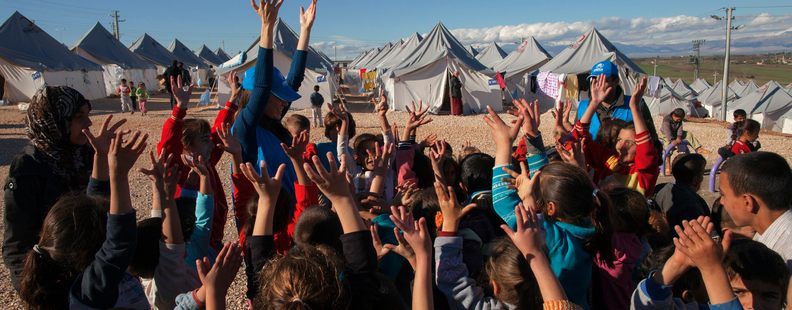Roy Amara coined the phrase “We tend to overestimate the effect of a technology in the short run and underestimate the effect in the long run.”[1] Sweeping changes, transformations that fundamentally alter the way the world works, are easily discounted or ignored … even by us, the drivers of innovation.
It’s an uncommon person, even an active leader of change, who imagines a revolution in his or her own world. And yet, we innovators are not immune to disruptive change. Our art can be turned on its head just as easily as any other practice.
So, as a start to a new year, I’d like to explore three shifts that lie on the near horizon in the field of innovation for humanitarian aid and development. Each is exciting in its power to disrupt the disrupters in 2015.
Genuinely Personalized Services: The Smart World
We are about to receive an exciting new set of tools. Very quickly it will enable radically new creativity in the design of personalized context driven services. It is rooted in three technology trends, each with the dubious distinction of being over-hyped fads. Big Data. The Internet of Things (IOT). The Cloud.
To date, the hype around these tools has seemed a bit overblown. That’s not surprising. Most new technologies make their debut as bright and shiny objects, inventions touted in breathless articles of a flying-cars future. Early in their life they are applied in isolation to pre-existing business challenges or inconsequential demonstrations of coolness.
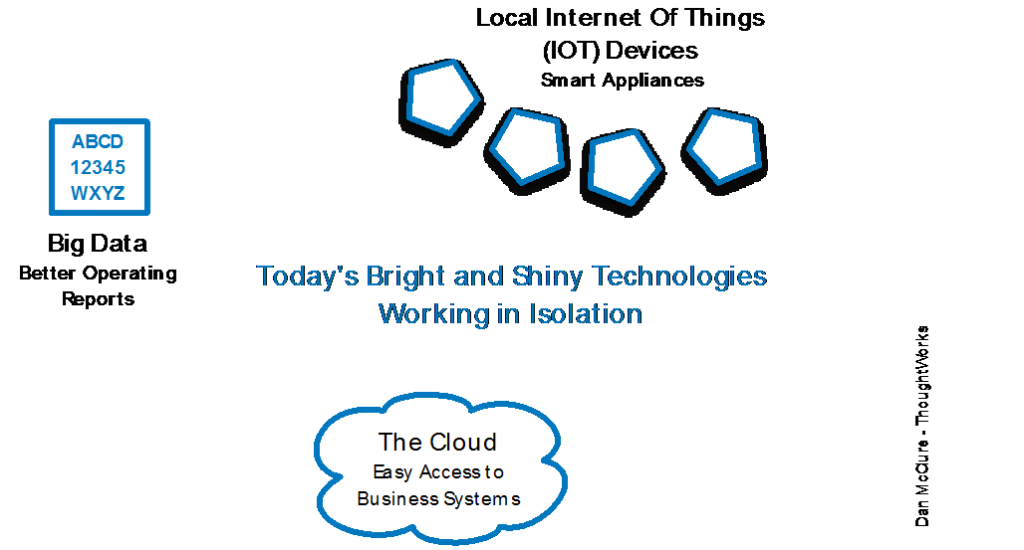
This bright-and-shiny object phase persists until the technologies mature sufficiently to become part of a broader creative ecosystem. This happened back in 2007 when Apple finally knit together mobile phones and digital content with an Internet platform and application development community. The concinnity of the combination drove an explosion of impactful new ideas in mobile.
2015 is ripe for another of these dramatic intersections. By 2020 projections are that there will be 35 zettabytes of data generated annually[2] (zettabytes?) and 40 billion IOT devices.[3] When these two monumental waves of capability are finally joined together amazing new things can happen. We will be able to leap frog many of the existing service models that dominate current programming.
The Cloud provides the missing link. It joins actors to information and ubiquitous touch points. Think of the new ecosystem as a cycle. Local sensors from the Internet of Things, feed real time data into the world of Big Data. This produces insight, which a global community of actors can access through the Cloud. They can then drive a context appropriate response back down to specific individuals or situations leveraging a growing array of financial devices, printers, and controls (more Internet of Things).
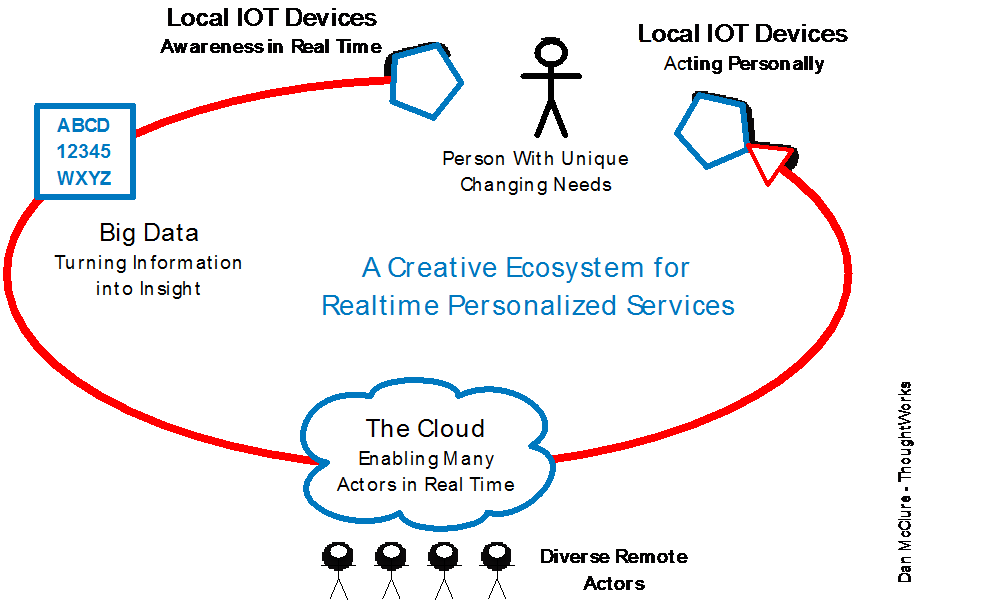
This ecosystem makes it possible to engage communities of action from afar to deliver a new generation of highly personalized services in a real time context. Buildings that announce when they fall down, medicine that tracks its condition during rough shipment, or prosthetics that are printed on site, can transform the efficacy of humanitarian responses.
The Crisis Mapping and prosthetic design communities have already demonstrated that remote actors are willing and able to mobilize around needs that exist on the other side of the world. With this ecosystem it becomes possible to create – even in highly volatile and chaotic environments – unique, customized services specifically tailored to an individual person’s need at the moment.
What’s disruptive about this is the extent to which aid and development engagement models can be re-thought from the ground up. Instead of mass produced solutions delivered in bulk, hundreds and even thousands of individual responses can be crafted to meet a moment of need.
This new ecosystem comes entangled with deep challenges around privacy, but for communities in crisis it radically expands the responses that can be crafted for challenges in health care, education, nutrition, and security.
Getting Serious About Scaling – The Missing Middle
2015 also provides an opportunity to take a hard look at our ability to scale good ideas. Over the last few years, the widespread energy around “innovation” has created a space in which new programs and thinking could be put in place. It is to the sector’s credit that so many pilot and exploratory programs have flourished. So many pilots have been done, that at this point they can seem like a herd of baby bunnies.
Unfortunately, stories of deployment and adoption at scale are far less common.
Ian Gray[4] and I wrote about this scaling challenge last summer[5] and have since heard the drumbeat of concern from donors and practitioners about the pervasive issue of “pilot-titis”. The sector has long known how to replicate and optimize proven practices (like building school buildings) and now we have the capacity to explore new ideas (innovative pilots), but there is still a missing middle.
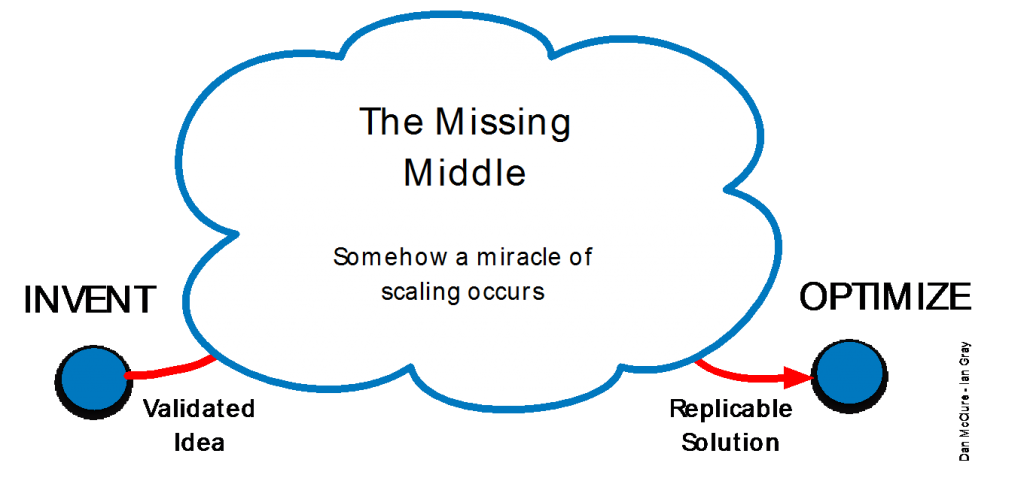
Something must be found to connect these two skills. The solution is not to simply do better Pilot programs. Done right, a Pilot program should not be ready to replicate. The early stage model of lean innovation used in a Pilot is all about flexibility and learning. This nimble exploration of ideas is necessarily different from the complex architecture of systems and people needed to bring a proven idea to scale.
What is disruptive here is that Scaling Up and Scaling Out are fundamentally different kinds of work. Innovators must engage with an entirely new level of complexity. They must fill in missing pieces of a solution, swap out make shift parts of the early design, and deal with wicked problems that permeate real life change and adoption.
It is not enough to simply fail fast and learn quickly. The scaling journey must construct complex architectures that span multiple dimensions; messy political challenges, inconsistent and varied technical landscape, sustainable business models, immature supporting supply chains, support for adoption and training, and providing the next generation leadership when the original passionate owners are gone.
It’s not just the work that changes. The way contracts are shaped and administered must shift too. Scaling through the missing middle requires sustained commitment, much longer than the typical time boxed pilot program. Funding, management, and measurement models will need to be tailored to support these extended, less easily measured, models of complex change.
Arrival of Competitors – Innovating to Remain Relevant
Finally, our places of work are poised to be upended. Competition has arrived on the wings of accelerating innovation. Historically, the humanitarian and development sectors might be seen as leveraging the relative poverty of the sector as a defense against competition.
Organizations with legacies dating back to World War II are common. Yet, this is not the pattern seen in most other areas of organized human endeavor. Yale’s Richard Foster points out that, “The average lifespan of a company listed in the S&P 500 index of leading US companies has decreased by more than 50 years in the last century, from 67 years in the 1920s to just 15 years today.” [6] By 2020, more than three-quarters of the S&P 500 will be companies that no one has heard of yet.
What makes 2015 a potential turning point, is the increased capacity for competitors to enter the aid and development fields, pushing aside traditional players. The challenges come from multiple directions. New solutions, new providers, and new funding models all have the potential to drive competitive disruption.
New solutions are capable of dis-intermediating long term players, making their best skills irrelevant. Quite simply, the key skills of many organizations won’t be needed tomorrow. For example, the move from goods to cash based aid devalues supply chain management expertise and an organization’s ability to put boots on the ground. New tools like the intersection of Big Data, IOT and the Cloud further democratize the ability to deliver better and fundamentally different services to troubled regions.
Business models are ripe for change too. New technologies extend the areas that can draw commercial interest. Telecom and financial service providers are increasingly entering the field with legitimate business opportunities
The potential for restructuring exists on the donor side too. Crowd sourced and individual funding becomes an increasingly viable option as direct access to crisis services grows. Oxfam offers donors an ability to buy a symbolic goat. Little will prevent individuals from buying that goat directly on behalf of people that they interact with in real time.
Choices multiply for institutional donors too. Local and non-traditional players can be granted a bigger role. As technology amplifies the speed and quality of feedback from the field, these organizations can become part of even risk adverse aid portfolios.
What makes this disruptive is that it is not a one-time challenge. An organization’s response cannot be to make a few immediately pressing changes and then sit back for another 60 years of steady operation. An innovation driven environment creates a new era where deep systemic change is part of the daily demands placed on organizational leaders.
Think of this as the curve that has driven the sector throughout most of its history. Periods of innovation are followed by extended periods where skills are applied and refined. It’s a model that supports stability and long term players.
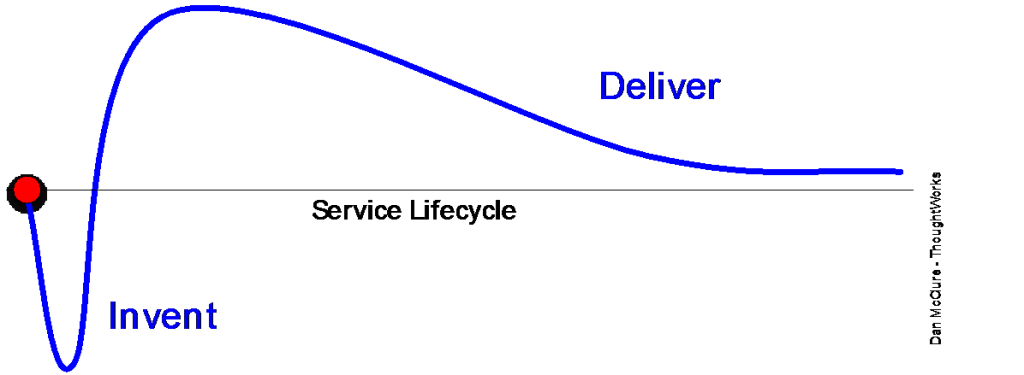
However, when innovation driven competition arrives, the forces of dis-intermediation, new business models and financial restructuring increasingly make proven services obsolete. The lifespans of proven service offerings shrink.
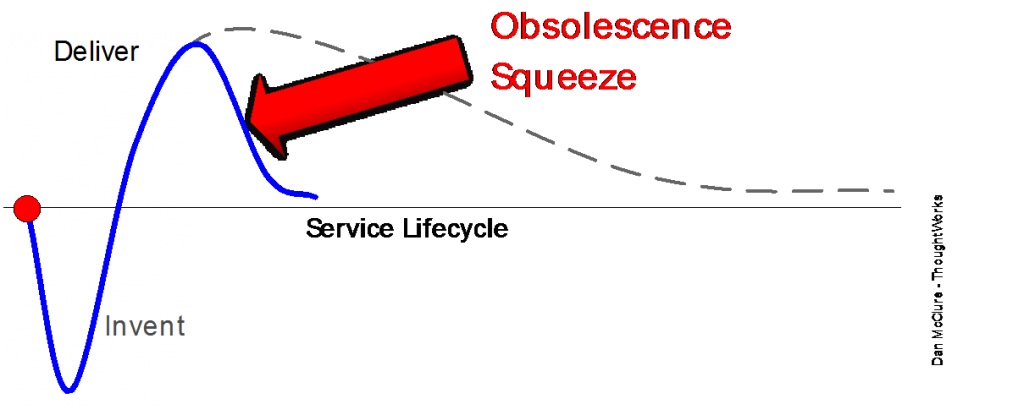
As a result, the ability to sustain a relevant position in the field is dependent on yet another wave of innovation. The goal of an organization increasingly shifts from one of optimizing established services to inventing new reasons for relevance.
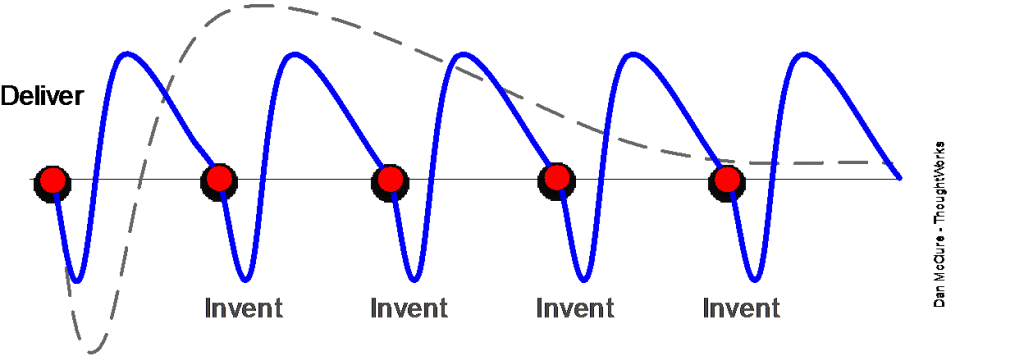
Serial innovation[7] is a huge change and few organizations are ready. A far different kind of organization is needed to deliver this steady stream of reinvention. As with the Fortune 500, many trusted names will fail to make the shift.
Disruption for the Disrupters
Will each of these changes mature within the span of twelve months? Probably not, but they are rooted in deep systemic drivers of global change. The shape and detail may vary, but some form of these disruptive changes will roll across our field with devastatingly broad affect.
What should we do? As the innovators of innovation, our goal could be to become the exception to Amara’s Rule. Who better than us to recognize the scale of the transformations ahead and prepare for the turmoil and opportunity that will result?
[1] http://en.wikipedia.org/wiki/Roy_Amara
[2] https://www.marketingtechblog.com/ibm-big-data-marketing/
[3] https://www.abiresearch.com/press/the-internet-of-things-will-drive-wireless-connect
[4] https://uk.linkedin.com/pub/ian-gray/15/196/961
[5] http://www.worldhumanitariansummit.org/node/472051
[6] http://www.bbc.com/news/business-16611040
[7] http://www.thoughtworks.com/insights/blog/rise-serial-innovator
About the Author
Dan McClure has spent 30 years designing and applying innovation practices across a diverse range of enterprises. He specializes in the architecture of sustainable systems of creative innovation. Today, he leads Innovation Design initiatives for ThoughtWorks, where his clients include humanitarian and public good organizations working to advance their ability to drive disruptive change.
If you’d like to repost this article on your website, please see our reposting policy.

